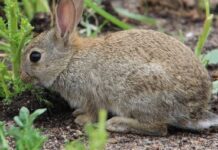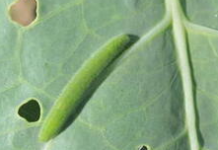https://hnr.k-state.edu/extension/info-center/newsletters/index.html
Blog Post: http://www.ksuhortnewsletter.org
Video of the Week: Planting a Garden
https://kansashealthyyards.org/all-videos/video/planting-a-garden
REMINDERS
1. Remove dead canes from raspberries and blackberries.
2. This is a good time to plant cabbage, broccoli, cauliflower transplants as well as lettuce, kale, beets, carrots and Swiss chard if you haven’t done so yet.
TURFGRASS
Henbit and Chickweed in Lawns
The plant with the little purple flowers that have been showing up in home lawns is called henbit. If you are not sure this is what you have, check the stems. If they are square rather than round, you have henbit. A plant that also is low growing but has round stems and tiny white flowers is chickweed.
Both these plants are winter annuals and start to grow in the fall. They spend the winter as small plants and so most people do not pay much attention to them until they start to flower in the spring. Trying to kill either one at this late stage with a herbicide usually is a waste of time and money. Though plants may be burned back, they will rarely be killed. So what should you do? Remember, these are winter annuals that will die as soon as the weather turns hot. Keep the lawn mowed until nature takes its course.
However, you can do something next fall that will help the following spring. There are two possible courses of action, as far as chemical controls go. The first is to apply a preemergence herbicide in early to mid-September. This will prevent henbit and other winter annuals from germinating. Preemergence herbicides labeled for both henbit and chickweed include prodiamine (Barricade), dithiopyr (Dimension), isoxaben (Gallery), pendimethalin (Halts and others), oryzalin (Surflan and Weed Impede) and XL. All but Surflan, Weed Impede and XL are also labeled for speedwell. The second course of action is to wait until late October or early November (after most henbit has germinated) and use a postemergence broadleaf herbicide, such as those mentioned above. With this approach, most of the henbit will be killed but, because small numbers of henbit continue to germinate through the late fall and winter, some plants will be missed. This approach works well because henbit is relatively easy to kill in the fall and many people want to treat for dandelions at that time (i.e., October) anyway. Just remember you will have to do some spot-spraying in the spring if you want to get all the henbit. As a final note, henbit will not be very competitive in dense, healthy lawns, so good cultural management will reduce the need for herbicides.(Ward Upham)
FRUIT
Fertilizing the Home Orchard
Fruit trees benefit from fertilization around the bloom period, but the amount needed varies with the age of the tree. Normally, trees primarily need nitrogen, so the recommendations are for a high nitrogen fertilizer such as a 27-3-3, 29-5-4, 30-3-3 or something similar. Though recommended for lawns, these fertilizers will also work well as long as they do not contain weed killers or crabgrass preventers. Use the following rates:
Trees 1 to 2 years old, apply one-fourth cup of fertilizer per tree;
Trees 3 to 4 years old, apply one-half cup per tree;
Trees 5 to 10 years old, apply 1 to 2 cups per tree;
Trees more than 10 years old, apply 2 to 3 cups.
You may also use nitrate of soda (16-0-0) but double the rate recommended above. If a soil test calls for phosphorus and potassium, use a 10-10-10 but triple the rate.
On apple trees, last year’s growth should be 8 to 10 inches, cherries should have 10 to 12 inches, and peaches should equal 12 to 15 inches of terminal growth. If less than this, apply the higher rate of fertilizer, and if more, apply the lesser amount.
Spread all fertilizer evenly on the ground away from the trunk of the tree and to the outer spread of the branches. Water in the fertilizer with at least 1/4 inch of water if rain does not do the job for you. (Ward Upham)
Fertilizing Grapes
Year of Planting: Apply one-half cup of a 10-10-10, 12-12-12 or similar fertilizer per vine as growth begins in the spring. Repeat after one month. Fertilizers should be spread evenly from the trunk out 3 to 5 feet.
Second Year: Apply 1 cup of a 10-10-10, 12-12-12 or similar fertilizer per vine as growth begins in the spring. Fertilizers should be spread evenly from the trunk out 3 to 5 feet.
Mature Vines (3 years and older): If the soil test recommends phosphorus and potassium, use a 10-10-10, 12-12-12 or similar fertilizer at the rate of 2 cups per mature vine. Fertilizers should be spread evenly from the trunk out 3 to 5 feet.
If, however, there are adequate levels of phosphorus and potassium, add 3/4 cup of a high nitrogen fertilizer such as a 27-3-3, 29-5-4, 30-3-3 or something similar instead of the 10-10-10. Though recommended for lawns, these fertilizers will also work well as long as they do not contain weed killers or crabgrass preventers. Fertilizers should be spread evenly from the trunk out 3 to 5 feet. (Ward Upham)
VEGETABLES
Blanching Cauliflower
When exposed to sunlight, most varieties of cauliflower heads will turn a yellowish shade. Not only is this unsightly but the flavor may be bitter as well. To prevent this, shield the heads from the sun by covering them with the leaves. This process is called “blanching.” Gather the outer leaves of the cauliflower plant and bind them with a rubber band, tape or twine over the cauliflower heads early in the season as they’re just developing. Monitor the plant growth to ensure the head remains covered through the season. Self-blanching varieties of cauliflower are available in which the leaves naturally grow around the head. Even these varieties require monitoring as the heads grow and leaves may need to be secured together to fully cover the heads. (Cynthia Domenghini)
MISCELLANEOUS
Clover Mites
Though clover mites are large by mite standards, they are still smaller than a pinhead. Because they are so small, they can easily invade homes through tiny openings around windows and doors. Though tiny, clover mites are very noticeable due to their reddish color. They are also easily identified by their long front legs, which are about twice as long as the other legs.
Clover mites do not bite people (they are plant feeders) or directly damage home furnishings but can leave unsightly stains on curtains, walls, carpets and other structures if they are crushed.
Mites can be removed from inside the home with a vacuum cleaner. Bags should be removed
and sealed after use to prevent mites from escaping.
It can also be helpful to try to prevent clover mites from entering the home through the use of physical barriers and miticides. Mites do not readily cross loose, clean, cultivated soil, so a band about 18 to 24 inches wide all around the house, kept free of grass, will help deter potential invaders. Also, clover mites are so small that applying talcum powder, diatomaceous earth, corn starch or baking soda around entry points can stop clover mites by creating a barrier. Even double sticky tape placed on windowsills will catch the small mites when they try to pass. Replace the tape when it fills. Do not crush clover mites as they will leave a rusty stain.
Homeowners can also keep mites from entering the home by spraying the outside walls and border areas of the lawn and cultivated soil with effective miticides next to the foundation. Try to treat when daytime temperatures will be at least 60 degrees F because the effectiveness of
miticides is greatly reduced by cooler temperatures. Spray outside walls and foundations with
lambda cyhalothrin (Spectracide Triazicide, Scimitar) or bifenthrin (Hi Yield Bug Blaster
Bifenthrin, Hi Yield Bug Blaster II, Talstar). The house should be sprayed from the lower windowsill down to the ground. Pay particular attention to cracks and crevices in clapboards, shingles, foundation and around basement windows. Be sure to spray up and into the area between the bottom of the house siding and the foundation. (Ward Upham)
Controlling Grassy Weeds in Broadleaf Plants
Most gardeners are familiar with herbicides that can be used to eliminate broadleaves from grasses (i.e. dandelions from lawns). However, gardeners may not be as familiar with herbicides that can take grasses out of broadleaf plants like shrubs. There are two major weed killer types labeled for homeowners that are used to kill grassy weeds in broadleaf plants. On the commercial side, the trade names for these products are Fusilade and Poast. Homeowner labeling is more diverse. I have seen Fusilade sold under the names of Ortho “Grass-B-Gon”. Poast is sometimes sold to homeowners under the Poast label but I’ve seen it more commonly sold as “Bonide Grass Beater”, “Fertilome Over the Top II Grass Killer”, “Hi-Yield Grass Killer” and “Monterey Grass Getter.” There may be other trade names, too. Fortunately, you can identify the product by the common chemical name listed on the label. Fusilade’s common chemical name is fluazifop, and Poast’s is sethoxydim.
If you decide to use one of these products, read the label carefully. Often, a crop oil must be added to the spray solution for the herbicide to work well. Some grassy weeds are not controlled such as bromegrass and sandbur. Mature tall fescue also is not controlled though seedling tall fescue is. Established bermudagrass is knocked back but rarely killed.
Though both these products can be used over the top of numerous broadleaf plants (including iris), there are some differences in labeling. For example, if you need to control grasses in vegetables, choose Poast as Fusilade is not labeled for vegetables. However, Poast products cannot be used on all vegetables and the waiting period between spraying and harvest may be so long as to make use impractical. To see a label for one of the products that contain sethoxydim, see Hi-Yield Grass Killer. (Ward Upham)
There Never Used to be Fruit on Ornamental Pears
The fruit on ornamental pears is quite small; about the size of a marble. However, it can be very messy if it lands on sidewalks or driveways and people squish the fruit when walking or driving. You may have noticed that ornamental pears are producing fruit much more commonly than they have in the past. Why is this so? A little history is needed in order to understand what has happened.
Ornamental pears used to be called Bradford pears. This was a bit of a misnomer as ‘Bradford’ was a specific variety. Ornamental pears were called Bradfords because this was practically the only variety that people planted. Therefore, if you bought an ornamental pear a number of years ago, it was likely a Bradford. All was well and good until people noticed that Bradfords would fall apart after a number of years due to a weak branching structure. Therefore, nurseries started selling “improved” ornamental pears that were not Bradfords such as ‘Aristocrat’, ‘Capital’, ‘Redspire’, ‘Chanticleer’ and various other varieties. It was felt that all of these varieties had a stronger branching pattern that ‘Bradford’ but such may not be the case. Both ‘Chanticleer’ and ‘Redspire’ have shown branch breakage. ‘Aristocrat’ does appear to have better branch angles but more time is needed to make a firm recommendation.
Here is the key. Pears usually require cross-pollination in order to fruit. In other words, you must have two different varieties of pear before fruit forms. When all we had were Bradfords, we had no fruit due to a lack of cross-pollination. Now that we have such a mixture of varieties, we will get fruit as long as two different varieties of ornamental pears bloom at the same time and are close enough that bees can work between them.
This formation of fruit can also lead to a second problem. Volunteer trees can come up from the seed contained in the fruit. Therefore, you may see ornamental pears come up in areas where no one planted them. This has become enough of a problem that several states have added ornamental pears to their invasive plant list.
There are products that are sold as fruit preventers such as Florel but timing and air temperature are critical and our results have been mixed. (Ward Upham)
Planting Easter Lilies Outside
If you’re wanting to prolong the life of your Easter lilies here are some tips to keep them growing outside after they finish blooming indoors.
1.) After blooming, remove the flower stalk to avoid energy being spent on generating seeds.
2.) Keep lilies indoors until the last frost date has passed. Soil should be kept moist, but not waterlogged. Fertilize as needed.
3.) Move the plant outside once the threat of frost is over. Keep the plant in the same pot and continue regular watering and fertilizing until the top growth dies back.
4.) Plant the bulb in a sunny, location with good drainage. Incorporate organic matter to improve drainage by tilling peat moss into the top six inches of the soil.
5.) Bulbs should be planted 6-inches deep and 12 to 18-inches apart. Water well and add mulch to maintain moisture. New growth may appear later during the summer or may not appear until next spring.
6.) In the fall, cover the dormant plants with 4-inches of straw, or 3-inches of pine needles, wood chips or other mulch for protection.
7.) In the spring, uncover the plants to allow new growth to appear. Fertilize as needed based on soil test. (Cynthia Domenghini)
Contributors:
Cynthia Domenghini, Instructor
Ward Upham, Extension Associate
Division of Horticulture
1712 Claflin, 2021 Throckmorton
Manhattan, KS 66506
(785) 532-6173
For questions or further information, contact: [email protected] OR [email protected]
This newsletter is also available on the World Wide Web at: http://hnr.k-state.edu/extension/info-center/newsletters/index.html
The web version includes color images that illustrate subjects discussed. To subscribe to this newsletter electronically, send an e-mail message to [email protected] or [email protected] listing your e-mail address in the message.
Brand names appearing in this newsletter are for product identification purposes only. No endorsement is intended, nor is criticism implied of similar products not mentioned.
K-State Research and Extension is committed to making its services, activities and programs accessible to all participants. If you have special requirements due to a physical, vision or hearing disability, or a dietary restriction please contact Extension Horticulture at (785) 532-6173.
Kansas State University Agricultural Experiment Station and Cooperative Extension Service K-State Research and Extension is an equal opportunity employer. Issued in furtherance of Cooperative Extension Work, Acts of May 8 and June 30, 1914, as amended. Kansas State University, County Extension Councils, and United States Department of Agriculture
Cooperating, Ernie Minton, Dean.




